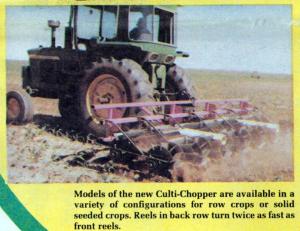1978 - Volume #2, Issue #4, Page #01
[ Sample Stories From This Issue | List of All Stories In This Issue | Print this story
| Read this issue]
New Do Everything Tillage Tool
 |
The first models were slated to roll off the assembly line as this issue of FARM SHOW went to press. "We think it's one of the biggest-ever breakthroughs in crop cultivation and tillage," Larry Branson, president, told FARM SHOW.
The first-of-its kind tillage tool is made up of two rows of blade-type reels, similar in design to those used on horse-drawn cornstalk choppers. Standard machines are 3 pt. hitch mounted (pull type models available on special order), and are designed to operate at unusually high speeds- 7 to 8 mph. The reels are ground driven with the back row of reels turning twice as fast as the front row. (A roller chain drive off the front reels is geared so as to double rpm of the rear reels.)
"This difference in rotation speed is a key feature of the machine," explains Branson. "For seedbed preparation, the slower turning front reels break up large clods, stalks and residue, while the faster turning reels in back prepare the seedbed for planting. For crop cultivation, the front reels tear out weeds and loosen the surface soil. The faster-turning rear reels throw loose dirt in and around the crop to kill close growing weeds. Used as a cultivator, it will run circles around a rotary hoe. What's more, it doesn't cost any more than a roaary, yet does a lot of additional jobs you can't do with a rotary," Branson points out.
Here's a closer look at the Culti-Chopper's unique features:
The one machine does the work of four or five and is tailored for both row crops and solid seeded crops. For row crops, it's made up of reels which match your particular row width. For example, you can buy a CultiChopper designed to cover up to 12 30-in. rows at a time. If you irrigate, the machine can be used with bedding equipment to prepare the seedbed and also to cultivate the bedded crop.
The one machine also serves as a stalk or straw chopper, and secondary tillage tool in a "once over" operation. In some situations, it can go right into standing soybeans, corn stalks or straw stubble as a primary tillage tool, Branson points out. With row crops, it becomes a high speed cultivator for weed control. "As a cultivator it can travel 7 mph even in freshly emerged row crops - without covering the crop or injuring it in any way," says Branson. "For corn, soybeans, cotton or sorghum, farmers looking for a way to cut down or possibly even eliminate chemical weed killers, the Culti-Chopper may be the answer because of its ability to take out weeds of all sizes, and its ability to do the job even when operated in young crops at extremely high speeds. For the farmer who uses herbicides or insecticides, the machine
produces an egg-beater type action for incorporating chemicals into the soil."
Another key feature is that the Culti-Chopper doesn't take a lot of horsepower. "Because it's ground driven, a 40 to 50 hp tractor will handle a 12 row machine," says Branson. Rocks don't bother the machine and it can be equipped for special "hitchhiking" operations, such as attachments to apply ammonia, dry or liquid fertilizer as a field is worked in the fall or spring. It also has good flexibility for tieing into once-over planting and tillage operations for a wide variety of crops, whether planted in rows or solid seeded. Irrigation farmers can use it in conjunction with special "furrowing out" plows.
Individual rectangular blades making up the reels are made of hardened steel similar to that used in plow shares. "On prototype machines, the reels are still in good shape after covering more than 10,000 acres," according to Branson. Reels on row crop models can be replaced by solid reels for use in fields being planted to wheat or other solid seeded crops. The changeover requires only about an hour, Branson told FARM SHOW.
He adds that, "we'll be conducting on-farm demonstrations of the new Culti-Chopper this summer and fall. If you'd like to see it work, let us know. We'll tell you when and where a demonstration is

Click here to download page story appeared in.

Click here to read entire issue
To read the rest of this story, download this issue below or click here to register with your account number.




